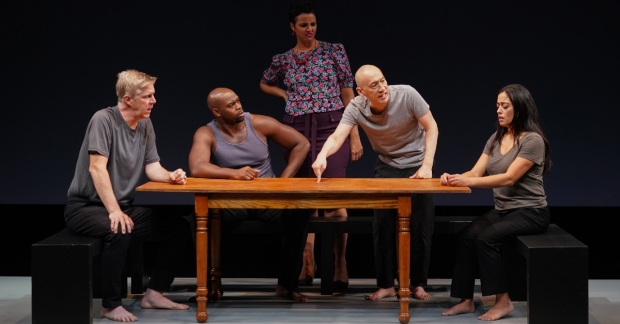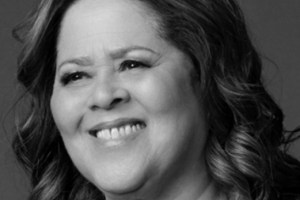Review: A Revised Twilight: Los Angeles, 1992 for Five
Anna Deavere Smith’s documentary play returns, in reimagined ensemble form, in a new Signature Theatre production.

(© Joan Marcus)
Anna Deavere Smith didn't need to revise Twilight: Los Angeles, 1992. As last year's Black Lives Matter protests in the wake of the George Floyd murder proved, the racial and societal issues Smith explored in the aftermath of the riots that erupted in Los Angeles after the acquittal of four police officers in the Rodney King beating are sadly still with us. Nevertheless, for the new Signature Theatre revival opening tonight, Smith has gone back to her already brilliant piece of documentary theater and come up with a new version that is, in some ways, a different show than previous productions.
On the micro level, Smith has both rearranged already existing interviews and added more material than previously seen. But the chief innovation of this revised Twilight: Los Angeles, 1992 is that what was previously a solo play has been transformed into an ensemble piece for five performers — but not just for any five performers. For this production, director Taibi Magar has assembled an ethnically diverse cast with Elena Hurst, Wesley T. Jones, Francis Jue, Karl Kenzler, and Tiffany Rachelle Stewart.
Within this troupe of five, there is a fluidity of racial and gender roles. Unexpectedly, for instance, it's Jones, not Kenzler, who intones the words of Charlton Heston, joking about how some of his liberal friends asked him for guns amid the citywide violence. And Jue closes out Act 1 with a solid approximation of the innate opulence of the late, great singer Jessye Norman. All five performers share the stage while speaking the words of Cornel West at the beginning of Act 2; while later in the second act, Smith has fashioned a "Dinner Party That Never Happened," with the cast members monologuing at each other while sharing a meal at a single table.
With calls for diversity in theater having only gotten louder in the past year and a half, the casting could be seen as Smith's own gesture of widening the field, and doing so in a manner that visibly reflects the racial diversity of the piece itself. The approach turns out to be a somewhat mixed blessing in practice, however. Some of the performers occasionally skirt the edge of caricature: Kenzler makes a meal out of the anonymous talent agent who professes to have seen the writing on the wall regarding the LA riots; same with Hurst as Elaine Young, a real estate agent in Beverly Hills who engenders much public ire after an unfortunate television interview she gives while the riots are happening. Still, all of the performers have their terrific moments: Jue is a marvel of sorrowful delicacy as he portrays various Korean-Americans impacted by the riots; Stewart exudes authority while reciting a speech given by Congresswoman Maxine Waters; Jones burns with fury as Keith Watson, one of the assailants of white truck driver Reginald Denny.
Magar has gone for an abstract, art-installation-like effect with her staging. Scenic designer Riccardo Hernández has populated the stage with multiple screens: a large screen toward the back, two smaller ones on the sides, and one screen above a raised platform. Onto these screens, projection designer David Bengali projects subtitles identifying speakers, evocative Los Angeles skyline imagery, and key pieces of video footage from the time. (George Holliday's video of Rodney King's beating is projected onto the large screen — content warning for those triggered by graphic violence.) As screens have become even more prominent in our lives since 1992, the multi-paneled stage design feels like an appropriate evocation of contemporary times. Also appropriate, if rather distracting in the moment, is Magar's choice to have stagehands dump trash and debris onto the raised platform preceding the section of the play depicting people's experiences during the riots themselves. As the actors navigate the messy stage, we find ourselves fearing for their safety the way many in Los Angeles must have feared for theirs. Magar's direction rarely falters, but her choices sometimes threaten to draw too much attention to themselves rather than serving the material.
Thankfully, the material itself remains as potent as ever in its wide emotional range, intellectual curiosity, and sheer compassion. In a time that remains as divisive as ours, the re-emergence of Smith's play in the theatrical landscape reminds us of the possibility of art — especially art as shaded with journalism as Twilight: Los Angeles, 1992 is — as a unifying force. If this revival accomplishes anything, it demonstrates the enduring power of Anna Deavere Smith's great work, one that doesn't need the magnetism of only one performer to convey its strengths.









